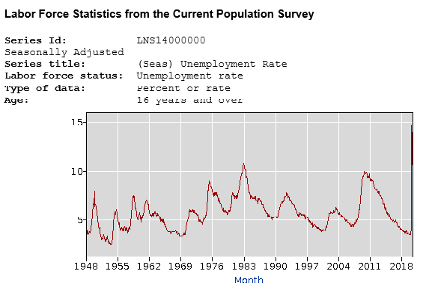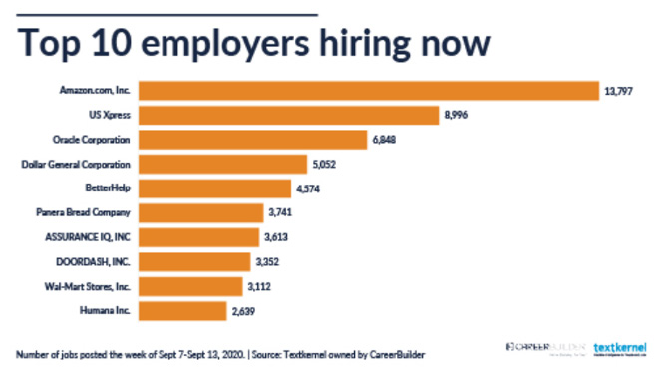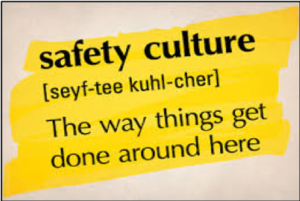

Doesn’t expecting the unexpected make the unexpected expected? This phrase is a play on words but there’s an underlying principle at play-in general, we can expect unforeseen circumstances or events to happen. In early 2020, organizations both large and small experienced a shock to their systems when the global pandemic COVID-19 afflicted the health of so many and affected economies across the world. Shortly thereafter both essential and non-essential organizations were forced to strategize ways to stay afloat amid lockdowns, quarantines, and tumultuous social states of affairs. While no one could have predicted that events would play out as they have, in many aspects of life history repeats itself.
 If you look at historical statistics, you can surmise that the labor market has peaks and valleys much like a roller coaster. Examing data from 1948 forward, we see that the US unemployment rate peaking at a little over 10% in the 1980s (retrieved September 30, 2020, from www.data. bls.gov). Most will remember the recession that began in December 2007 and ended in June 2009 (National Bureau of Economic Research Website). Indeed, expecting the unexpecting makes the unexpected expected when it comes to employment and the labor markets affected by various socio-economic factors to include pandemics and associated recessions.
If you look at historical statistics, you can surmise that the labor market has peaks and valleys much like a roller coaster. Examing data from 1948 forward, we see that the US unemployment rate peaking at a little over 10% in the 1980s (retrieved September 30, 2020, from www.data. bls.gov). Most will remember the recession that began in December 2007 and ended in June 2009 (National Bureau of Economic Research Website). Indeed, expecting the unexpecting makes the unexpected expected when it comes to employment and the labor markets affected by various socio-economic factors to include pandemics and associated recessions.
During this most recent pandemic, many organizations have focused their attention on Human Resources and Talent Acquisition strategies. Why? Well, this pandemic has impacted the financial and operational states of businesses that have in turn disrupted their respective workforces-employees have been furloughed, terminated, or retained. Retained employees have fallen sick and their recoveries can equate to weeks of being out of work until they are cleared to return to work. However, in the case of businesses considered essential services, they have continued to hire, and often depending on how great the demands are for their goods or services, they have an increased need to hire thousands of workers.
 For example, since the early months of this pandemic companies like Amazon, Walmart, and Dollar General have hired thousands of workers during this pandemic to meet the demands for their goods and services (data retrieved from September 30, 2020, from www.careerbuilder. com). Therefore, an organization’s human resources are a key component in managing various shifts in the workplace as Talent Acquisition is tasked with meeting the demands of hiring higher volumes of employees based upon the needs of organizations.
For example, since the early months of this pandemic companies like Amazon, Walmart, and Dollar General have hired thousands of workers during this pandemic to meet the demands for their goods and services (data retrieved from September 30, 2020, from www.careerbuilder. com). Therefore, an organization’s human resources are a key component in managing various shifts in the workplace as Talent Acquisition is tasked with meeting the demands of hiring higher volumes of employees based upon the needs of organizations.
However, in organizations that are operating with lean staffing models and suspended hiring in the interim until the financial health stabilizes, what role can Talent Acquisition play in navigating the uncertain landscape? Many experienced talent professionals have navigated the currents of recruiting during both good and not so good times in past decades and their experience likely demonstrated that the only thing constant is change. Although we cannot have predicted COVID-19’s impact due to so many variables, engaged talent teams can use the fundamentals of a recruitment strategy to stay afloat and achieve certain success.
Whether your organization is experiencing a hiring freeze or is tasked with hiring, there’s no better moment to use time wisely and examine basic strategies of recruitment for navigating the unsteady talent landscape. A few ways to navigate recruitment during a pandemic are to:
1. Keep communication intact with your organization’s leadership.
2. Update old recruitment strategies.
3. Find new ways to connect with potential candidates.

As part of an essential services organization, Southern Cross partners in providing various utility services throughout many local communities in the US. Our staffing needs have varied each month and we have faced staffing challenges during busy times to keep the pace. The labor market varies from state to state and at times there are challenges in finding qualified candidates who not only desire to work but also have the right circumstances to work during the pandemic amidst obligations to care for themselves, family members, or children. Considering such a diverse recruitment landscape talent teams do well to keep leadership informed and communicate updates as needed. Regular communication with leadership can help talent teams anticipate changes in staffing and proactively navigate turbulent labor markets. Communication can serve as a compass during such disruptions-it’s an instrument to help your talent team navigate direction as needed.
Communicating with your organization’s leaders can include requesting to be included in relevant meetings that might provide insight on company direction, goals, and updates. You can reach out to your manager regularly to provide talent updates. You can also take the time to get to know other key operational individuals in your organization-think about which operations partner with talent acquisition and start to build a relationship with them. By keeping your ear to the ground by communicating with as many stakeholders as possible, you will be in a better position to manage recruitment proactively as much as possible. And even more so, you will have developed relationships with key individuals willing to partner with you and ultimately impact the success of your recruitment strategy.


If your organization’s recruitment needs have slowed during the pandemic, why not take the opportunity to re-evaluate your processes, workflows, and ramp-up strategy? Before COVID-19, many recruiters were constantly churning the wheels of recruitment without having much time to ask “why” we perform certain routine tasks-pretty much auto-navigation recruiting. Somewhat like riding a bicycle whereby you hop on the bike and start peddling, so it is when you receive a new requisition and just start recruiting. It can become a monotonous process. Well, now might be a great time to put the brain back into your process.
Think about your typical recruitment workflow and from there question each step in your funnel and flow, reconcile the recruitment process against feedback you’ve gleaned from your communication outreach campaign (aforementioned in this article), and lastly, revamp your recruitment strategy. Likely, the positive changes made will improve recruitment metrics overall or depending on your area of focus. Hint: check your talent metrics at a future date after implementing certain changes and the metrics will hopefully reflect positively on the improvements made. Some key areas to consider kicking it up a notch are:
1.Updating job descriptions and marketing materials.
2.Strengthening your screening and interviewing process.
3.Improving ways to connect on a personal level with candidates.
There’s no denying that there is beauty in antiques, but is it time to refurbish or completely revamp your recruitment marketing material? Your once stellar recruitment job postings and communication materials might have returned great results in the decade they were conceptualized and created; however, in 2020, they likely require some refreshing. And even more so during a pandemic, companies are forced to find ways to connect with the labor market. Why not find ways to incorporate videos into your funnel? Include video links in your job postings, in candidate communications, and on your career website.


One of the most important considerations to note during unstable recruiting periods-consideration of the candidate experience. Like most organizations, candidates are also navigating uncertain times and circumstances. Many are living and working under very stressful conditions. According to a recent LinkedIn survey, nearly 46% of hiring professionals said the outbreak (pandemic) has negatively affected the candidate experience at their company (retrieved on 10/1/2020 from www.linkedin.com) Without the ability to interview in-person, meet with recruitment and hiring managers, and attend new hire orientations, candidates are finding it challenging to connect to potential employers virtually. Rather humorous (but maybe not so much) is that a Microsoft study concluded that our attention spans are now shorter than that of goldfish-goldfish are ahead by 1 second (at 9 seconds) and we lose concentration at about 8 seconds.
Whether your organization is currently hiring or not, connecting with potential candidates should still be a top priority because, at a future time, your talent brand will need to attract candidates when hiring restarts. So how should you source qualified candidates and provide a good candidate experience? Re-imagine your recruitment process through the perspective of the candidate-how can you reach your candidate audience?

Why not connect to a greater degree with potential candidates by adding videos into your recruitment process? One survey found that 85% of internet users in the US watch videos and for those that watch these videos they spend about 5 minutes 30 minutes more on pages with videos versus pages without videos. If you consider the use of videos on social media applications like YouTube, Facebook, Instagram, and newcomer Tik Tok, the use of videos in advertising and branding is growing exponentially. Quite simply-people like videos and they connect with visuals.
Perhaps you can include videos or links to videos in your job postings to give a brief snapshot of the job (it will likely capture the interest of candidates more than reading two dozen bullet points of the position’s responsibilities). You can also include use video messaging or include links to intro communications to the candidate. During this past year, companies have moved to using video platforms for onboarding new hires and conducting new hire orientation and training sessions. However, you decide to use videos in your process or funnel, make it candidate friendly by keeping it real (authentic), brief, polished, and actionable-make sure there is a call to action messaging so that the candidate knows what to do next or what to expect next from your talent team.

Although much is still unknown with how this era of the pandemic plays out, one thing is certain-change
for the better. The economy will certainly recover and the labor market will follow suit. Indeed, expecting the unexpected makes the unexpected expected does not just apply to negative circumstances but positive outcomes, too. Revamping your hiring process and recruitment strategies now can pay off later when economies recover. It may seem like we are living in a never-ending story and things will never return to normal but history teaches us that they will return to normal-a new normal or a better normal.
Your talent team can navigate thru these turbulent times by using tools to enhance your business processes while time is ample to do so. Make your talent strategy even better by improving communications within your organization, ramping up on basic recruitment strategy, and focusing on connecting to candidate audiences. With proper navigation techniques, you will eventually anchor at said destination with qualified and well-nurtured candidates in tow.
Southern Cross is positively and optimistically making the unexpected expected by working hard to advance our organization and solve our customers’ problems. We partner with our people and customers by instilling a culture of integrity, innovation, and good old-fashioned teamwork. If our values mirror your own and you have an interest in a career in utility services, please feel free to learn more about us at www.southerncrosshire.com.

References:
- https://data.bls.gov/pdq/SurveyOutputServlet (Labor Force Statistics from the Current Population Survey)
- https://www.careerbuilder.com/advice/10-industries-hiring-thousands-of-workers-right-now (Top 10 Employers Hiring Now)
- https://business.linkedin.com/talent-solutions/blog/talent-leadership/2020/biggest-challenges-for-recruiters-during-coronavirus (Candidate Experience)
- https://hiring.monster.com/employer-resources/recruiting-strategies/talent-acquisition/how-video-humanizes-recruiting/
Videos:
- https://time.com/3858309/attention-spans-goldfish/
- https://www.nber.org/cycles/sept2010.html (NATIONAL BUREAU OF ECONOMIC RESEARCH)
- https://www.statista.com/statistics/273909/seasonally-adjusted-monthly-unemployment-rate-in-the-us/(TABLE 2)
- https://www.bls.gov/news.release/pdf/empsit.pdf (PANDEMIC AUG 2020 UEMPL RATE)
Nicole Moore | Talent Acquisition Specialist | Southern Cross










